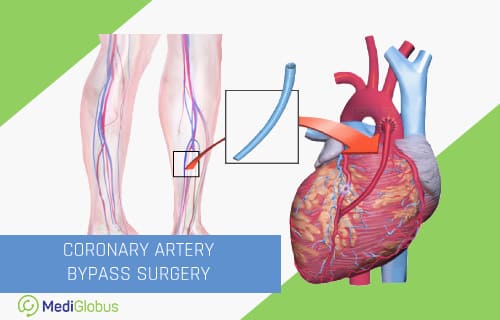According to the WHO, coronary heart disease is the leading cause of death worldwide. About 10 million people die of it every year. If the disease has already occurred, the most effective way to protect yourself is an aortic coronary bypass. Modern cardiac surgeons perform this procedure in the highest quality and safety possible. In combination with a healthy lifestyle, aortic coronary bypass in case of coronary heart disease can return the patient to normal life expectancy. How this procedure works and how much it costs in foreign clinics – you can read in this article.
Coronary artery bypass surgery?

Aortic coronary bypass is an operation in which the doctor transplants new vessels (grafts) to create additional pathways for blood. Most often, veins or arteries of the arms, legs and chest are used.
Coronary arteries are vessels that supply blood to the heart muscle (myocardium). If they are damaged or not working properly, the whole body suffers.
Blood clots prevent blood from flowing normally. The consequences of blood clots depend on where they are located and are generally not favourable.
Aortic coronary bypass is performed if a person has poor blood flow to the heart muscles. Most often, this problem occurs in narrowed coronary arteries or blood clots. The procedure lasts from 3 to 6 hours, depending on how many vessels you need to move.
Aortic coronary bypass does not treat diseases that cause clogged blood vessels. But it significantly eases unpleasant symptoms and reduces the chance of dying of heart disease. This is the most popular heart surgery. Aortic coronary bypass, performed using modern methods, has practically no effect on life expectancy. In the USA alone, 500,000 such procedures are performed every year.
Who needs coronary aortery bypass surgery?
Aortic coronary bypass is most commonly performed to treat acute coronary heart disease (ACHD). It is a disease caused by coronary vascular dysfunction. Due to the lack of oxygen and nutrients, irreversible damage to the heart muscle can occur.
The main symptom of coronary heart disease is burning pain behind the sternum, most often occurring after physical exertion or emotional shock. Coronary heart disease is one of the main causes of disability and death in the world.
For the majority of people, aortic coronary bypass allows getting rid of symptoms of coronary heart disease for 10-15 years.
In emergencies, aortic coronary bypass may be performed to treat a severe heart attack, also known as coronary thrombosis. This condition is a consequence of coronary heart disease when the heart muscle dies from the lack of blood supply.
The difference between the two is that in the case of coronary heart disease, you can get rid of the pain by taking nitroglycerin, and with heart attack, it will not help.

Aortic coronary bypass is also often performed on patients with diabetes. This is because this group of people are susceptible to forming clots. The bypass can keep them safe in the future.
Except for emergency cases, the decision to perform an aortic coronary bypass is made by a team of specialist physicians based on an analysis of the patient’s medical history, test results, and general condition. Some patients are better off doing angioplasty instead – mechanical dilation of the affected artery.
Diagnostics before aortic coronary bypass
Electrocardiogram (ECG)
A method for measuring the electrical activity of the heart. It can be used to detect damage to the heart muscle.
Echocardiogram
Visualizes the function of heart valves.
Stress tests
Doctors examine the function of the heart under stressful circumstances. Usually, a treadmill is used for this, but sometimes medications are injected instead that increase the heart rate.
Coronary angiography
Allows the doctor to see the extent of the lesion and the exact location of the affected arteries. During this procedure, a small catheter is inserted into the patient’s vessels.
CT angiography
An alternative to coronary angiography for patients with whom catheters cannot be used. Instead, a contrast substance is injected into the blood that will be visible in the image during the CT scan.
Evaluation of coronary artery calcinosis
Estimation of the amount of calcium on the inner walls of vessels. This method is performed with computer tomography (CT).
How does aortic coronary bypass work?
During an aortic coronary bypass, the surgeon transplants blood vessels from body to heart, forming new paths bypassing blocked ones. The surgery is performed under anaesthesia. To maintain a normal supply of oxygen to the body, doctors use an artificial lung ventilation device.
There are three main options for performing aortic coronary bypass:
Open surgery using a blood pump machine | During this operation, the surgeon stops the heart for the period when grafts are attached to the coronary arteries. The patient is connected to an apparatus that enriches the blood with oxygen and supplies it to the body as the heart would do. After the new vessels are attached, the doctor starts the organ again. Often it starts to work by itself when the blood circulation machine is turned off, but sometimes surgeons use a defibrillator. |
Open surgery without using a blood pump machine | This procedure is considered more difficult because it is performed on a moving heart. For some groups of patients who are prone to complications, this option is preferable. These include the elderly with ventricular dysfunction, people with kidney disease, diabetes or chronic lung disease. |
Minimally invasive surgery | In this case, the doctor places the vessel through a small incision on the left side of the chest, between the ribs. This procedure is often performed with the help of the Da Vinci robot, which allows for more precise movements. |
Rehabilitation after aortic coronary bypass

After an aortic coronary bypass, you have to stay in the hospital for at least a week. During this period, doctors will closely monitor the patient and perform additional tests to ensure that the procedure has been successful. The patient takes special medications that reduce the risk of blood clots, normalize heart rate and cholesterol levels.
Doctors can also perform oxygen therapy or install a temporary pacemaker.
Full rehabilitation takes 6 to 12 weeks. Patients who have undergone minimally invasive aortic coronary bypass surgery need less time to recover.
As with any operation, aortic coronary bypass involves risks. Side effects may include: arrhythmia, heart attacks and strokes, blackouts, bleeding, infections and kidney complications.
To avoid this, you need to carefully follow the doctor’s recommendations to change your lifestyle after surgery. This applies primarily to taking prescription medication, maintaining a balanced diet, physical activity and avoiding bad habits.
How much does aortic coronary bypass cost in foreign clinics?
The cost of aortic coronary bypass depends on the hospital, the qualifications of doctors, the method of procedure, the number of grafts, rehabilitation time.
| Clinic | Cost |
|---|---|
| Heart Center Helios in Leipzig, Germany | from €22,000 |
| Quironsalud Madrid in Spain | from €16,500 |
| Medipol hospital in Turkey | from $10,000 |
| Clinic | Cost |
|---|---|
| Medical Center Sourasky (Ichilov) in Israel | from $25,000 |
| BLK hospital in India | from $4,500 |
| American Heart of Poland | from $6,200 |
Resume
Aortic coronary bypass is the most common cardiac procedure. It is performed if the heart muscle is insufficiently supplied with blood in case of coronary heart disease or heart attack.
Aortic coronary bypass surgery is performed using open surgery or with a minimally invasive method. The choice of method depends on the patient’s health condition and the degree of disease. Sometimes a surgeon may recommend angioplasty instead of an aortic coronary bypass.
The result of bypass lasts for 10-15 years. 70% of patients are completely relieved of symptoms such as chest pain and shortness of breath.
To preserve the effect of aortic coronary bypass and reduce the risk of negative consequences, it is important to follow the doctor’s recommendations and have a healthy lifestyle.
In foreign clinics, an aortic coronary bypass is performed in all cardiology departments. Preference is given to minimally invasive and robotic methods. The price depends on the country and the clinic.
If you are looking for a clinic abroad for aortic coronary bypass, please leave your request on Mediglobus website. Our coordinators will contact you, answer all your questions and help you find a hospital for your treatment.





